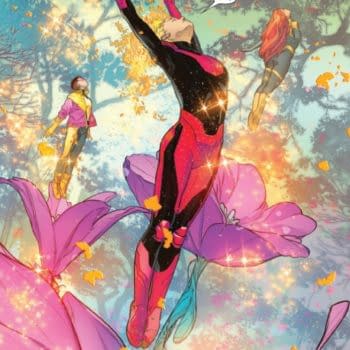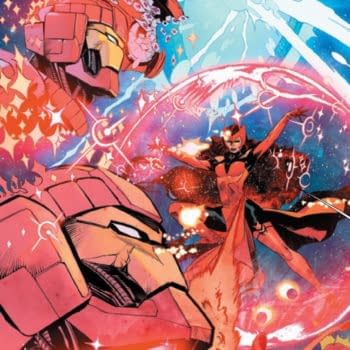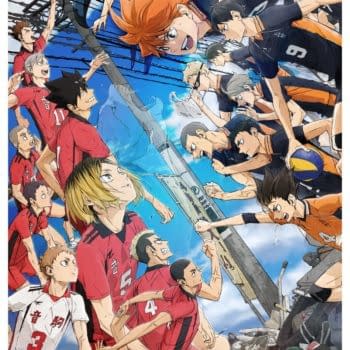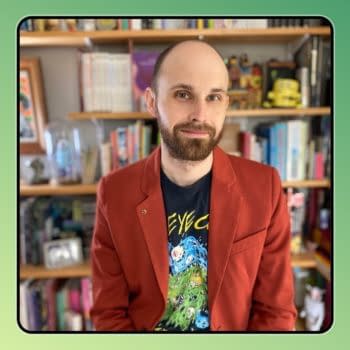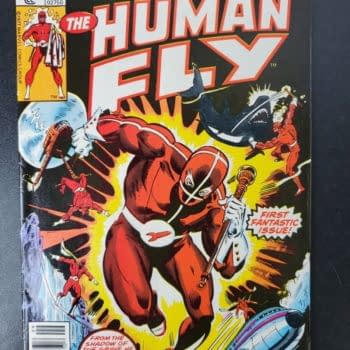Posted in: Comics, Recent Updates | Tagged: Comics, entertainment, image comics, indie Comics, joe keatinge, John Workman, Leila Del Duca, Owen Gieni, shutter
Shutter Is The Beautiful Comic That Doesn't Coddle You – The Bleeding Cool Double Interview With Joe Keatinge & Leila Del Duca
If we measure the impact of reading comics by the way they change our perspective of things, whether of human nature, of the unexplained aspects of the universe, or of our own motives and roles in life, Shutter, from Image Comics, has already been one of those impacting comics for myself and many other readers, just to judge from what I've seen online and heard in conversation. After reading the first collected volume and catching up to the series at speed, I concluded that the series is a remarkably brave one in very practically measurable ways. It doesn't follow conservative plot structures of returning to the status quo every few issues. It doesn't make it clear who should be identification characters in the ever-widening cast. And that's something that's true of the comic's trajectory as a whole–it's ever widening. It just keeps zooming out further and further on a larger and larger universe while making sure that you are still in step with a few key characters so as not to lose your way.

The creative team behind Shutter, comprised of writer Joe Keatinge, artist Leila Del Duca, colorist Owen Gieni, and letterer John Workman (earlier in the series Ed Brisson), have done something really remarkable in crafting this series and have sustained that feat over 12 issues. Issue #13 arrives next week on July 8th to start a new arc of the narrative. Both Keatinge and Del Duca join me here today on Bleeding Cool in an interview that spanned substantial discussion about the series as a whole, and then a follow-up chat about Issue #13 and the ways in challenged them.
Hannah Means-Shannon: Joe, As we talked about awhile back, the structure of Shutter is really unusual and long-game. Have there ever been times where you felt you needed to be more practical or conventional about the story-structure, in case the series came to an early close, for instance, or times when you made the decision to be individualistic about it?
Joe Keatinge: I firmly believe you've got to do right by your collaborators, characters and story before you start worrying about anything or anyone else. If you let a self-perceived recipient structure what you're creating, you're doing a disservice to everyone involved. And sure, there's an element of risk there, because as you said, series come into early closes all the time. It's all too common, even on the big corporate books.
And heck, I've had that happen to me before, but I think if you're going to do comics at all, but especially creator-owned comics, you've got to go all in. That doesn't mean everything should be some long sprawling epic, it could be six pages or six issues or sixty issues or whatever you want as long as it's just that – whatever you want. If I'm not doing my absolute dream book at Image, I'm doing it wrong. I'd rather spectacularly fail with something I firmly believe in than be mildly complacent with something my hearts not into.
Shutter's odd story-structure comes into some odd writer tics I've only recently noticed in myself. I like slow burn pacing, perhaps too much so, I like the book knowing more about what's going on than the reader, I don't like first issues which lay the whole situation the table, I think not explaining everything is a plus, I like jumping around in time in really odd, sometimes confusing ways and on Shutter especially I love making the initial spread somewhat jarring in presentation if not content. The tics can be awkward, they can flail, but they're mine.

Leila's got artistic tics which are odd in their own way too, but in the end, when you combine what she does with what I do and what Owen (Gieni, Shutter colorist) and John (Workman, Shutter letterer) this thing forms that wouldn't exist with us all individually and certainly doesn't exist outside all of us combined. It's ours. And I feel very, very lucky and grateful we've got an audience supporting this to such a degree that unless everything bottoms out tomorrow, we're going all the way with the story, the way we wanted it. If we played it "safe" to more conventional means, we'd likely just blur into the massive signal to noise there is with the sheer volume of comic books these days.
To illustrate that point from another perspective, I've started helping out with my local comic book shop, Floating World Comics, in order to learn what it's like to perceive Comics (big C) from another perspective, specifically retail, and it's been one of the most eye opening learning experiences I've engaged in since I started working in this industry. Some of it's obvious things which get stressed more than ever when you're the one cutting open boxes and taking in the inventory, going through books to sort for the rack, judging what gets displayed and what doesn't – and maybe it's how Floating World's run, but the books that do things their own way are the ones we're doing the best with.
I think our two biggest superstars over the last week have been Moomin's Tove Jansson and horror manga author Junji Ito. The only thing they have in common is that no one has ever done comics like those two. If you want the kind of thing they do, you have to go to them. They may have imitators, sure, but they are The Real Thing. You can't get Uzumaki by some creative team who was thrown together 30 years later and really want to be doing something else, but have to do this revamp because there's a lunchbox which needs to be sold.
Don't get me wrong; a lot of great comics I love come out of selling lunchboxes. I've written some and had a blast. I also specifically think this current Secret Wars is one of the best Super-Crossovers to exist in a while and this is said as a dude who's really picky about his Doctor Doom intake. On the other coast, Scott Snyder and Greg Capullo are doing things with Batman I never saw coming and what I've read is real damn good.
So, with Shutter, maybe we'll fail or maybe we'll succeed, but the only thing I know everyone on Earth has in common is that we're all dying at some point, so I believe whether or not it's your job, you shouldn't be creating anything, whether it's on comics you own or not, because it's What's Hot or What They Want. Be true to yourself and hopefully an audience will follow. Maybe they won't. Be true to yourself anyway.

JK: Shutter's got a strange DNA and a lot of it's outside of comics. I'd actually say the two main comics its got kicking around are Hergé's Tintin and the Fawcett-published Captain Marvel Adventures series. Cerebus is in there in terms of "f*ck it, let's get weird," despite some major issues I have with the series and its creator.
You know, I've seen people bring up Saga comparisons and on a very, very surface level I suppose I see why they'd think that. We're dealing with family issues. They're dealing with family issues. They've got a cat. We've got a cat. Yet on that level Shutter was developed and completely outlined story wise well before Saga was even announced, so as much as I love what Fiona and Brian are doing, I wouldn't say it was an inspiration in that regard.
However, Saga has had a massive impact on Shutter – heck, my entire living — in a way no one's really brought up yet.
Saga was really the forerunner of this present Image Comics renaissance, and along with books like Fatale, Bitch Planet, Sex Criminals, Southern Bastards, The Wicked + The Divine, and so on, it helped create this environment where a book like Shutter could exist on an economical level. The biggest names in comics put it all on the line, a lot like the founders did twenty-three years ago, and the repercussions are astronomical, so much so I think we're barely seeing the beginning of how drastically the industry itself is changed and will continue to change. Like Kirkman predicted in his 2008 (!) manifesto, "the more people who do creator-owned work, the easier it'll be to sell creator-owned work. [he was] one guy, [he was] out there, [he was] making a living, a good living. If there were two of [him], we'd be selling better. If there were six of [him], we'd be selling huge. If there were twenty of [him], fans would come."
And they did. That's exactly what happened. As much shit as he got for that video, online or in that Baltimore debate with Bendis, he was completely right.
It's one of the few times in economics when Trickle Down Theory actually works out the way people claim it will, because as a guy who's relatively new to writing, working with an astonishing, yet otherwise brand-new artists (Leila del Duca, the co-creator of Shutter, and colorist Owen Gieni. Our letterer, John Workman, is the most seasoned member of the team) on a really weird book where half of the cast are lion people and we're screwing around with format to an almost antagonistic degree, we're succeeding in ways I don't believe we could have five years ago. It's not limited to Image either. Look at the massive impact Raina Telgemeier has had. Like with those other books, I don't think we've even begun to see the full extent to the impact her work alone is going to be having on the art form, much less the industry around it.
Shutter's single issue numbers are currently okay, with signs that they're stabilized and likely going up, but they're at a level everyone can do the book and pay bills. That being said, our trade paperback numbers are insane (and those are mostly though independent comic stores, some of the strongest of which didn't even exist before 2010). Digital numbers are super strong. We're signing foreign licensing deals that are lucrative for us.
So, whenever I see people complain about how much lower sales numbers are now than they were in the 1980s, '70s, etc., I go nuts because they're largely comparing pre-returned newsstand numbers to un-returnable store single issues without taking into account how hugely diversified the economic structure has gotten in recent years. How we're actually reaching more consistent, regular readers than ever.
Shutter was a book I initially developed at a time when I had no idea what I was going to do with my life. I was broke. I wouldn't meet Leila for years to come. Glory wasn't on the table yet. Nothing else was in development at that point or going that well at all. So, I wrote up this thing and thought, if I could do anything, Shutter is what it'd be. But I thought, "That's too damn weird. No one's going to publish that, I should be doing X or Y instead."
And it took a while, I had to do X and Y to realize I didn't enjoy doing X and Y, but when it finally came time to jump all in on Shutter, Image was luckily interested in publishing it. We were also extremely lucky in the market place being situated so we can do the book the way we want to, as long as it needs to. We've run the numbers; we're seeing this sucker to the end.
I've had books completely misfire for multiple reasons, some creative, some economical, and so I get that when it comes to art, there are no guarantees and I feel extremely grateful I've been able to do what I have at the generosity of the people picking these things up. Books still fail. Everything could fall apart tomorrow, but there is no denying that there has been a permanent change, one ever evolving, to the industry, thanks to people taking bigger risks than ever with the art form. And that's how it should be, with art dictating economy.

JK: It's like I said earlier, when it was initially developed I was in a place where I had no idea how my career would turn out, so I developed the book I wanted to do more than anything. But again – who could develop it visually, who would've published it back then? I didn't have either at the time.
I came to a not entirely dissimilar crossroads in my career some years later, where I had a good time for the most part; I worked with artists such Richard Elson, Ricken, Valentine DeLandro and editors like Darren Shan, Jon Moisan, Alex Antone, Steve Wacker, Sana Amanat, Bill Rosemann, Mike Marts and Mark Doyle who helped me up my game in a huge way. I got to write Superman with a bunch of cool artists, I got to write an issue of Amazing Spider-Man, I got to contribute in a small way to one of my favorite runs on Batman, Piotr Kowalski and I had a ball tearing it up with the Hulk. Of course, this all came out of revamping Rob Liefeld's Glory with Sophie Campbell. All those projects were dreams come true with collaborators on all ends who improved upon those dreams in every single way.
But none of them were mine. None of them were The Book I conceived and developed and co-created with someone. So, after all that stuff passed, I decided to give Shutter a shot.
Shutter #1 debuted and it was the best reception anything I had done up to that point had received. It was the book I thought no one would ever want to work on, that no one would ever want to publish, that no one would ever want to read because it was all too weird. But luckily Leila, Owen and Ed (Brisson, our first letterer) did, Image was super into it and the kind people enthusiastic about our work has changed my life for the better.
The point of all this is, I figured it was time to get the stick out on all the books I kept telling myself no one would ever do, the way my collaborators and I want to do them, because I realized in the end that that's a good thing. It means we get to do them. Shutter was the first and I'm happy to say there's more coming.
And on a company level, between Image and its subdivision, Skybound (where I'm working with editors like Sean Mackiewicz and Michael Williamson, who continue to help me improve and succeed) have proven to be the best fit for the kind of work I want to be doing now. I don't think it's a coincidence that I'm now the happiest I've ever been creatively, personally and professionally.

JK: I knew Shutter was going to work when I first saw a panel Leila drew in issue #1, with Kate sitting on a subway with a minotaur in a suit and it seemed like the most natural thing in the world. Because it is in our world.
There's a thing when we consume our fiction that we often want things we really, really don't want. Like, in Blade Runner, one of my favorite things is that we never see the gunships off the shoulder of Orion. That's in my head. I'm more part of the world because I don't have it figured out as the viewer.
There are a lot of things about Shutter I know the answers to that I'll never explain, because that's boring. Kate and her story and growth are what's important. But that said, all the right answers are coming. My hope is the ones they don't get will form in their head similarly as the mysteries left unseen in Blade Runner did, forming a relationship between author and reader that's one of my favorite aspects about doing what we're doing.
HMS: Do you think it's important to make emotionally engaging characters but also not to coddle them? Some pretty brutal stuff happens in the comic, and there are consequences. Why be so direct about violence and suffering?
JK: Life's brutal, man. Life can suck really damn hard. Look at the news. People are getting shot all over the place. In my own country, racisms dictating how our cops brutalize people who have a different skin color and didn't do a damned thing vs. how they calmly escort out someone who actually shot off a gun nine times, but has a skin color they share. We're a broken society in an oft-savage world and I'm not even sure how to deal with it. I'm doing my best my educating my own ignorance and improving how I interact and enter the larger cultural conversation and even then I feel, as a citizen of the world, I'm falling short.
I don't see the point of coddling. Things don't grow when you coddle them and deny them the freedom to experience everything on their own, good or bad. Violence and suffering exist and it's disgusting and horrible, but if you're going to create a work with any level of honesty which is attempting to say something personal, I think you've got to have that in there in some form.
On the flip side, it's also a beautiful world with amazing art and architecture and cultures we'll never stop learning about. Humanity is capable of greatness.
To actually answer your question, I try to balance it the best I can in my own work, so things get wonderful for my characters and other times everything goes horribly wrong. Just like life.

JK: I never understand when I hear things from readers or viewers of anything when they say stuff like, "Oh, I'd never do what that character did" or "How could that character be so stupid"? I don't know about you, but I've done a ton of stupid shit in my life. I've done things I look back on and barely recognize as me. People are fallible, they're capable of doing beautiful things and being total dicks and being hugely generous and being repugnant and this is all in the same individual.
As Shutter starts, Kate's in a real bad place. She's in a full on clinical and situational depression, which is hard to shake. We've gotten critiques that she's not really the one in control in the beginning of the series and my answer is, "Well, she's not." Part of what interested me as both the author and someone who's dealt firsthand with severe depression was to examine all of that. Sure, Kate's journey has lions in pinstriped suits and dream dimension gods and titans racing across the multiverse, but my favorite part of the book is seeing is the personal journal, the small stuff which is actually the big picture — the who Kate was, who she is and who she'll become.
HMS: Leila, how on earth did you agree to draw so many different elements in one story, such as so many different types of settings, architecture, and characters? Was this a matter of choice to be so diverse, or are you just quite kamikaze as an artist?
Leila Del Duca: I didn't have any idea how crazy Joe was going to get with the visuals, but once he started throwing lion mobsters and ghost ninjas and all these fantastical elements into Shutter, I was immediately hooked. Originally, we agreed Shutter would be about 30% fantastical and 70% normal, but I guess Joe wanted to test me and push me as an artist, to let my imagination and skills run free, and by including these diverse elements he has done exactly that. I've never been so motivated, inspired and driven to create before, and that desire increases every day I draw Shutter.
So yes, now that I have it as an option, I do choose to have such diverse visuals. I think I was always into the idea of ridiculous, varied subject matter, but Joe was the first writer to bring it out in me and he's forever made an impact upon me and my interests as an artist.
HMS: Do you ever want to kill Joe when you find out about something crazy he wants you to include and illustrate? Are you adding your favorite things into panels as well?
LDD: Do I ever want to Kill Joe? No. Never. Do I get frustrated as f*ck when I encounter a page that's technically challenging? Yes. But that's one of the things I love about this comic. It challenges and pushes me in ways that get my blood pumping, that make me want to throw objects and cry, but that inspire me to overcome the hardships and be a stronger artist once I figure it out.
And I absolutely do add my favorite things into panels! It's so fun sticking a friend into a crowd scene, or drawing obnoxious banana and apple artwork hanging on a hospital wall. I have a running joke with my friend Tony Gregori that I always put squirrels in our comic sketch jams, so sometimes I stick a squirrel in a background just to spite him!
I'm also able to play around with page layouts and designs as I see fit. I wanted to draw some extra dinosaurs on page 8 of Issue 5, so I had them framing the page. Joe didn't write that in, but he's always trusting my choices as an artist and that's one of the reasons I love working with him. Eckland was originally a Tiger, but I made her a jackal because I wanted to and Joe's like "Great! Go with it!." Again, there's this trust thing where if Joe has an idea that I want to change, he's always receptive to hearing it, and usually changes it to suit my interests. It's amazing and rewarding working with someone like that.

LDD: My artistic decisions concerning this book came from a few different angles. I knew this was the first book of mine that people would actually see and and pay attention to. For one, I was going to be working with a writer who already had a following. Secondly, it was going to be published by Image Comics which has a huge group of readers and who will actively put our book on the shelves so lots of people will see it. This was my chance to impress and I didn't want to screw it up.
Next, I asked myself, "Well, here's your chance to show everyone what you love about comics and what stylistic influences you want to incorporate as an engaging, fun style. But keep in mind, Leila, that you have to still be fast enough to draw a monthly." I chose to be loose about my inking style because I love the sketchy quality of Sean Murphy and how doing loose inks allows me to finish pages quickly. My brushes would often crap out on me so I was inspired to incorporate dry and split brush inking because Mark Schultz's dry brush is freaking beautiful and my tools weren't always working out how I wanted them to. I drool over Mike Mignola's light/dark ratios in his work so I challenged myself to add more blacks and shadows.
That was just the beginning. I also wanted to throw in diversity with people, animals, plants, buildings, EVERYTHING, because I didn't want to bore myself or others by doing the typical, expected things. I didn't want a perfect, stereotypically beautiful leading lady so I gave Kate a lanky body, a pointy nose, and an almost comical way of acting. With every new character, I exaggerate their acting in a way that is believable to me, how people in the real world act, so when I'm drawing Shaw, I think about how a real person would act and I just transfer it over to his lion body. I treat every character as if they're real people and that allows me to make them act appropriately and believably.

LDD: The grossest thing I had to draw so far is in issue 13! There are two bloody scenes that are pretty gross, but excellent additions to the story. A close second is when Shaw got blasted by Chris, Jr. and I had to keep drawing his bloody, destroyed body over and over again in various panels.
The most beautiful and satisfying piece I drew was probably…this one's hard! Every issue I draw so many things I love drawing! I can't even… But I guess the double page spread in Issue 6 where Kate is sitting on a log in the woods is near the top of the list. So is the last page of Issue 9 where the CMYK gods watch Kate and Kalliyan fall down the Ben Day dot portal. And the double page spread of the Dragon Abomination Creature blasting the side of the cliff in Issue 7. And the covers. Drawing the Shutter covers is always so satisfying. In this upcoming arc, Issues 13 and 15 have been my favorite so far.

LDD: Joe does write a lot of epic double page spreads into Shutter, another reason that I dig this comic so much! Spreads are a nice break from the panel-to-panel storytelling and let me focus more on one illustration instead of 2 or more on a page. They're a mental break, even when there are a ton of elements.
I approach double page spreads knowing to keep any important elements out of the center, since that's where the page is folded, and then I design everything around that. I also still keep in mind that it should lead the reader's eye off the right of the page so they feel a little more inspired to turn the page. Unless I want them to pause in the moment a little more. In that case, I design the composition to direct the reader's eye bit more to the left so they stay there a second more before turning the page.
After that, it's about including all the necessary visual elements while sustaining the desired emotion we want to convey. Sometimes it takes forever to arrange, sometimes it doesn't. But it is always fun and rewarding.
HMS: Are there any things you are really obsessed with drawing that you haven't yet had a chance to do?
LDD: Hilariously, no! I've had so many opportunities to draw things I'm obsessed with and care about that I'm more than satisfied. Even the letters column lets me be satisfied by talking about what bands and television, etc, I'm currently into. There hasn't been a moment during Shutter where I think, "Oh shucks, I wasn't able to express myself adequately." I'm always satisfied!
HMS: To turn now to Issue #13 and the new arc, Joe, how much are you willing to tell me about the origin and obsession with Venetian imagery and carnival figures for you as a writer?
JK: You know, I'm actually surprised no one's asked about this before as Shutter's not my first book to feature Venetian imagery, but it sure gets blatant in issue thirteen.
It's a weird thing and I'm not even sure of when it actually started or even entirely why. As I remember it, the initial interest crept up through fiction first and foremost, whether it was in Hugo Pratt's Corto Maltese, Kubrick's Eyes Wide Shut, Arthur Schnitzler's Dream Story (which Eyes Wide Shut was based on) & Casanova's Return to Venice, John Berendt's City of Falling Angels, Luciano Visconti's Senso, or even Moonraker.
My interest grew a lot when I started getting into its actual history. Whether it was Venice's relationship to the Silk Road, its overall historical role in international trade, Napoleon's takeover, various Doges, it's architecture and the role mysticism plays, then specific non-fiction like Jan Morris' World of Venice, John Ruskin's Stones of Venice and Paul Morand's Venices – it altogether built up in my head that Venice would be the most fascinating place I could possibly visit.
That said, I was initially let down once I made the trip. It seemed like a sort of Venetian Disneyland — a Westernized and commercialized bastardization of what I had been reading about all these years. The greatest example of this was stumbling across a Hard Rock Cafe featuring a bunch of fellow Americans dancing to a KISS cover band.
I remained very grateful to be there, so during the day I did the tourist rounds of visiting places like St. Mark's Square, The Doge's Palace, Caffé Florian, the Peggy Guggenheim Collection and the Rialto Bridge. Basically everything short of taking a Gondola. It was a fun experience, but still felt like Disneyland.
Then things got really interesting at night.
At night I had no idea of what to do nor did I know anybody there, so I decided I'd hit up the various bars I had read about, like Harry's, and got really damn lost in the process. I couldn't make heads or tails of where I was, even with the Ulmon map app on my phone, but instead of worrying I just rolled with it. What followed was hours of walking down streets I probably shouldn't walk down (not necessarily for any fear of safety, but a couple of times there I realized I was on private property), walking into districts on the other end of town which I had absolutely no familiarity with. That kind of thing. And while it was frustrating at first, it ended up wonderful.
Because going into the wrong districts meant I saw how locals lived. I actually noticed more of the weird sigils on houses and tucked into corners. The differing versions of St. Mark's Lion and noticing some carried swords, other carried books, and so on, and what that meant the families there were born from or trying to escape. Finding random gardens with beautiful statues of various saints, creatures and folklore (which, again, I probably shouldn't have been in), particularly in the Cannaregio district.
But the weirder thing is the later it got, the more it took on this strange dreamlike effect (which I feel ridiculous talking about, but it's the only thing I can think of comparing it to), like the state between going to bed and entering lucid dreaming. I'd hear voices in the distance, but never run across anyone. I'd keep turning into corners, which dropped straight into water. Its eerie, random nature felt like it operated on dream logic more than anything else. Again, I feel ridiculous admitting this, but I can't think of anything else to compare it to. I've never experienced anything like it sober.
So, I wandered around Venice until the early morning, in a discombobulated haze the whole time.
I loved it.
The next day I cracked open what I was surprised to be my best resource, a guidebook written around Hugo Pratt's work with walking paths by people who actually knew where they were going and what they were seeing, The Secret Venice of Corto Maltese: Fantastic and Hidden Itineraries by Guido Fruga and Pratt apprentice, Lele Vianello. That what explained what I was running into, what it all meant, explaining the various links to Kabbalah. That sort of thing. I wish I had read it before I left, so I guess that's the overall point of all this – if you're going to go, grab that book and you'll be much better off for it.
The other point is through the fiction and non-fiction I read, through the odd experience I had once I was there, it completely latched onto my imagination. I think the biggest thing is I don't entirely get why I'm fascinated by Venice to the extent I am as I do think it goes beyond the historical, cultural and folklore, so squirreling it into my work over and over again is this possibly Sisyphean pursuit of trying to understand why this city has latched onto my brain. Maybe some day I'll figure it out. Maybe I won't.

JK: There's always something to some extent. Often times it's more of a moment than a whole scene, like wanting scenes of Kate just lounging around, although sometimes losing bigger moments (or more like postponing them until later) happens too. Issue fifteen has a whole section I had to cut out and thought doing so would ruin the whole thing, but it ended up as Leila's favorite issue. Like I said before, you need to think about your collaborators, characters and story first and foremost. And I do think there's truth to work never being truly finished or exactly the way you imagined it.
Everything important gets in there. Everything else exists in the ether.
HMS: Do you get any anxiety about introducing new characters into the narrative? Do you feel they have to be heavily involved in future installments or is it more important that they get their shot at a starring role in the short term?
JK: Not at all. One of my favorite things about comics is that you're only limited by what you and your collaborators can imagine. In our case, Leila's up for drawing anything and loves designing new environments and people, so she's the ideal partner for something like Shutter. But while there's no anxiety, everyone we introduce has to serve some sort of purpose. And they all do, but it's as you pointed out before, we work at a quirky pace, so someone might be introduced in issue one who won't come back or be relevant until issue twenty-five. Both of the major new characters to be "introduced" in issue thirteen were hidden in plain sight much earlier in the run. It's sort of like life, wherein some people you think will be a huge deal won't be, some in the background end up vital and more often than not, every one surprises you with where they end up going.
HMS: Leila, to ask you about the new arc, Venice is our setting in #13. How do you decide what details make a location recognizable to a reader and to "feel" like a place they might know?
LDD: Lucky for me, Joe wrote specific recognizable landmarks into the script and sent me reference photos for all of it. I've never been to Venice, much less overseas, so it was a huge help that Joe hooked me up with important visuals. From there, I give enough information, getting enough proportions right that those buildings are obviously buildings from those reference photos.

LDD: In New York in the first story arc, I was able to go crazy because that's the nature of New York in the world of Shutter. Venice is a lot more grounded, as Joe instructed, so he told me to leave a lot of fantastical elements out of the architecture to add to the mood of the place. I can still include weird creatures, hence the grape vine man and sea creature on the front cover, but Europe in Shutter is more tame when it comes to new, culturally-bent architecture and technology.
HMS: It occurs to me that it's often hard to tell if characters in Shutter are sinister or friendly, and in fact that's constantly changing. Characters seems to all have dangerous qualities. What aspects of design, body language, or expression help you convey that potential or those changes?
LDD: Joe usually doesn't tell me when a new character is going to be a bad guy in the end. He only gives me just enough information to draw the characters how they need to be portrayed in that time and place. Later into the storyline is when I learn if they have ill intentions or not. When their personality starts coming out in the story, that's when I start rounding out their range of expressions, body language, and designs. Initially, sinister characters will have more glares and self-important or menacing body language. Later, I introduce more smiles, warmth, and a sense of humor into their actions so that the reader warms up to them.
HMS: Thanks so much to Joe Keatinge and Leila Del Duca for doing this extensive interview!
Shutter #13 is out on July 8th!














